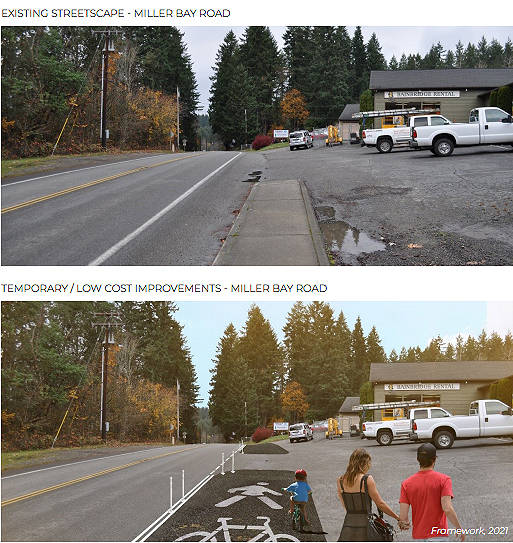A minority report has been issued to the Bainbridge Island Planning Commission along with the recommended draft from the steering committee regarding the Island Center Subarea Plan.
Also at Thursday night’s planning commission meeting, it decided to hold off continuing work on the Landmark Tree Ordinance until city arborist Nick Snyder returns from Family Medical Leave Act in late September.
Regarding Island Center, three of the eight steering committee members filed a dissenting report: John Decker, Michael Loverich and Sam Marshall, two architects and a transportation data analyst. They argue the draft report does not reflect what the Island Center community wants. They say such planning should not be from the top down, but instead listen to what the community says.
For example, the community said it doesn’t want increased housing density or commercial development – yet the plan that passed 5-3 does just that.
Adding housing density would create a financial burden on property owners to develop the needed infrastructure. Because affordable housing is needed, the community wanted all new housing to be affordable so that growth could be managed to the scale supported by the locals.
The goal is to provide housing for people working in the area, a workforce consistent with the blue collar and agrarian roots of Island Center, the minority report says.
The dissenters also object to the addition of 5 acres owned by one Island Center committee member due to insuffient public benefit in exchange for the upzoning.
“The dissenters requested inclusion of the communty’s input be accurately and fully represented in the draft plan,” the minority report says.
Also, community activist Chris Neal says in an email to The Review that two committee members who voted with the 5-3 majority did so because the draft report upzones their properties, which could benefit them financially. They did not announce that conflict of interest, and if those two votes were not counted it would have been a 3-3 tie.
In announcing the discussion that night, city planning director Heather Wright said they are just “setting the table tonight for a deeper converstion July 10.”
A summary of the draft plan says, in part:
On May 5 the steering committee completed its recommendation on a draft plan following three years of extensive discussion, outreach, review and analysis.
Some of the proposed improvements include:
*Transportation safety: Add new bicycle and pedestrian facilities and trail connections.
*Public improvements: 1. New outdoor public space: The plan proposes to improve a four-acre city-owned property on Miller Road to create a new flexible outdoor public space with connections to a trail network. The plan envisions incorporating some permanent recreational elements, such as seating and play areas, while allowing for varied uses at different times of day and seasons, with parking available for nearby uses and events. 2. Expand public and/or visual access to the Fletcher Bay waterfront in Island Center in partnership with private property owners, and recreation and conservation organizations.
*Land use and zoning: 1. This includes changes to development standards and permitted/conditional uses that serves to differentiate Island Center from Lynwood Center and Rolling Bay. 2. The committee voted to recommend Land Use Alternative 3, adding three areas to Island Center.
Also at the meeting, the Planning Commission had a 4-3 vote regarding delaying work on the Landmark Tree Ordinance.
“I think we need to move forward on this,” Commissioner William Chester said, adding tree ordinances have been talked about for at least the eight years he’s been there.
At first, Commissioner Jon Quitslund said he’d rather get the work done there on the fine points because there’d be a “lot more noise” when it goes to the City Council. But then he said he’d rather move it along, “even with certain imperfections. Some things can’t be fixed to be perfect.”
But Commissioner Sarah Blossom said one of the reasons there was a recent six-month extension on the ordinance was so they could continue to work on it.
Commissioner Lisa Macchio said the ordinance still has problems and just because we’ve been “spinning our wheels for ten years” doesn’t mean they should pass it up to the council. She also said public participation on the ordinance has been hindered due to COVID-19.
“I realize perfect is the enemy of good,” she said. But because of the issues in the law and lack of public input, “Shame on us,” for trying to pass it along.
As for landmark trees themselves, the commissioners struggled with coming up with a definition and value for them.
“I don’t know how you can have an ordinance without a definition,” said Kimberly McCormick Osmond, chair of the commission.
Snyder added, “How do you apply aesthetic values to people’s privately owned trees?”
He also said to get the public on board the city needs to provide guidance so they can be educated about trees and what the purpose is for the regulations.
As for deciding a tree’s value, Macchio suggested finding a way to get an economic analysis of a tree. “The world fails to value benefits from resources,” she said, but it would with a dollar amount valuation.
“That’s information someone who thinks in dollars” would get, she said. Then, someone might get why they have to pay to take a tree down on their own property.
“I see incredible value in my neighbor’s tree that’s 100 years old,” she said. “It’s not my tree; it’s my community’s tree.”
Snyder said there are tree appraisers who can “put monetary value on trees from an economic sense.” But there are also passive benefits of trees that add value.
“It’s pretty ambitious” to try to come up with such a valuation system, he said. “It’s a big change from how we do things now.”



